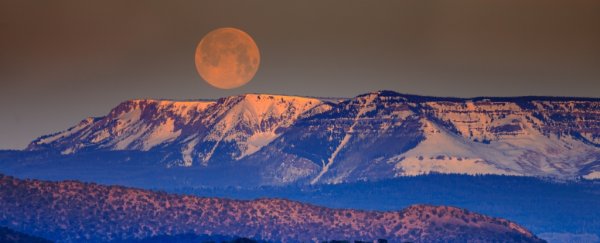In recent years, studies have shown that there is a correlation between the phase of the Moon and large earthquakes.
Now a new study has come out stating that there's actually no relationship between the two; and, for that matter, there's also no link between earthquakes and the time of year.
According to researcher Susan Hough at the US Geological Survey, any patterns that may link these events are no different from "the kinds of patterns you would get if the data are completely random."
Dating back decades, studies have found that more earthquakes occur at a specific time of year, such as this 1984 study that found more San Andreas fault earthquakes occur in spring, or this 1999 study that cross-correlated earthquakes with rainy seasons.
More recently, two separate studies in 2016 found that large earthquakes occur more often either during or near a full or new Moon.
(It's also worth noting that this 2003 study of earthquakes in Taiwan found a correlation between Moon phases and small earthquakes - but not large ones.)
The reason for this, those researchers determined, may be the alignment of the Sun, Earth and the Moon in relationship to one another.
During a full and new Moon, the three bodies are in exact alignment (this is called syzygy, which is an awesome word), and this places slightly more tidal stress on Earth, which could result in more earthquakes.
But Hough and her team have now examined 204 earthquakes of magnitude 8 or higher dating back to 1600, matching the dates on which they fell to phases of the Moon. They also noted when they occurred on the calendar.
Large earthquakes are better for studying these events, the team noted, because they are less likely to be just aftershocks.
The new research suggests that previous findings of correlation between earthquakes and Moon phases, or earthquakes and the time of the year, are simply the result of randomness.
While a number of unrelated earthquakes clustered around certain days, Hough was able to show there was no pattern by randomising the dates and finding the pattern vanished.
The highest number of earthquakes that occurred on any given day was 16 - and it was a day that fell seven days after a new Moon, not the least bit statistically significant if we go by the hypothesis that Moon phases and earthquakes are linked.
"When you have random data, you can get all sorts of apparent signals, just like when you flip a coin, you sometimes end up with five heads in a row," Hough said.
Tidal stresses, she noted, may contribute to earthquake processes, but their contribution isn't significant enough to enable the prediction of earthquakes or tremors. And even in the 2016 papers, the authors don't claim that their findings can be used this way.
But the notion that there is a relationship between Moon phases and earthquakes has a long history, and no doubt will appear again.
"Sooner or later there is going to be another big earthquake on a full Moon, and the lore will pop back up," said Hough.
"The hope is that this will give people a solid study to point to, to show that over time, there isn't a track record of big earthquakes happening on a full Moon."
The research is set to appear in Seismological Research Letters.
